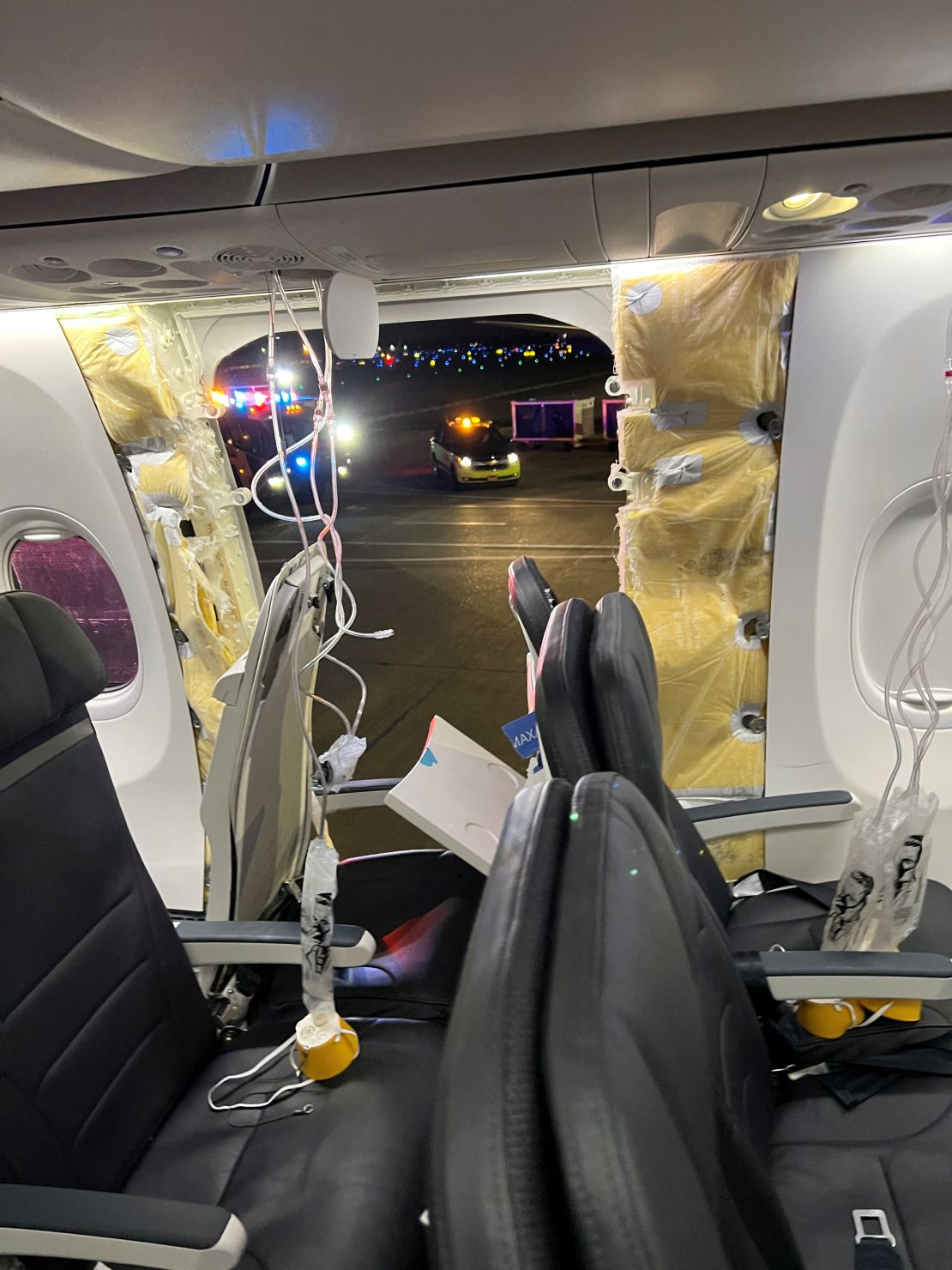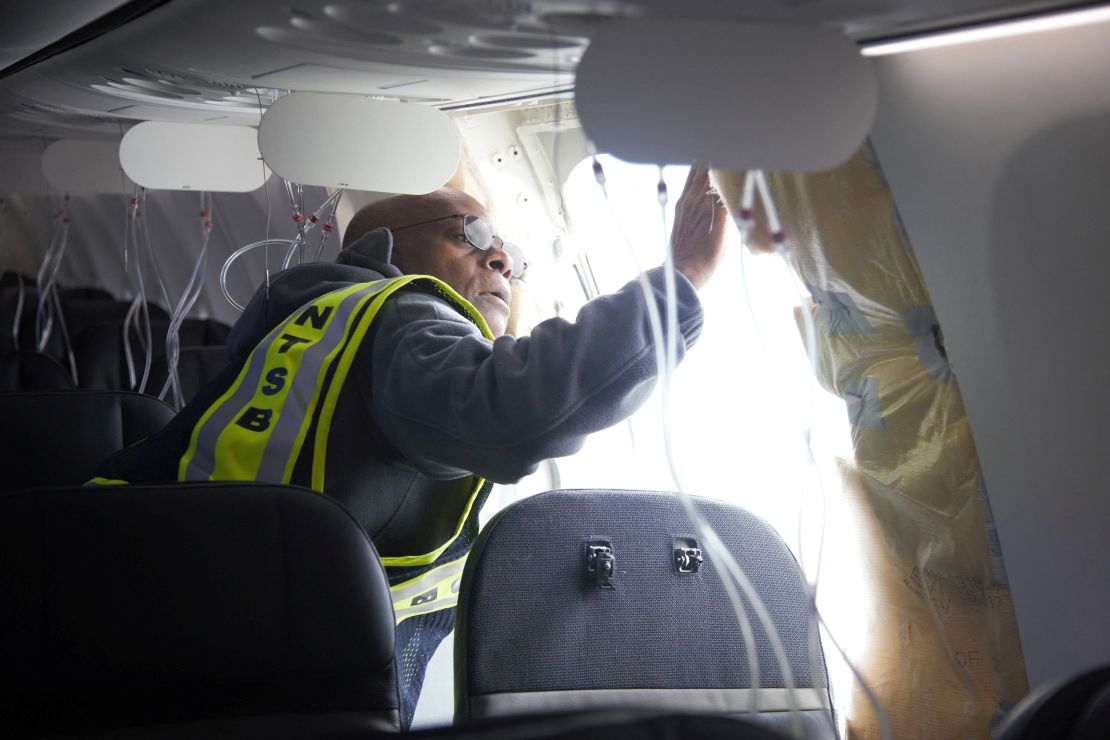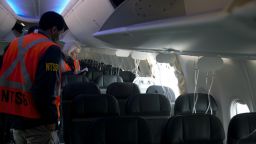There was a huge bang. A massive hole opened up in the side of the plane, minutes into a flight. Wind and noise filled the cabin, clothes and phones were ripped from passengers and hurled into the void. The metal of airplane seats twisted towards the opening.
It was an extremely lucky day.
Because for the 171 passengers, four flight attendants and two pilots on board Alaska Airlines flight 1282 who experienced all of that on January 5, it could have been so much worse.
“It’s fortunate that nobody died and there were not more serious injuries,” Jennifer Homendy, the chair of the National Transportation Safety Board, told CNN after touring the aircraft shortly after the incident.
The preliminary report on the incident was released earlier this month, and one of the most alarming notes in a long litany of them was just how many flights the Boeing 737 Max 9 involved in the fateful incident took before the door plug blew off because it left the factory missing crucial bolts needed to keep it in place.

The plane, tail number N704AL, had already been flying for Alaska for 10 weeks, going on 153 flights. Unbeknownst to passengers and crew that flew on it, and seemingly even the factory that built it, the terror that occurred was seemingly inevitable.
Every time a modern commercial airliner goes up in the air, it ever-so-slightly expands and contracts, like a balloon being inflated and deflated. Each time it goes up, the cabin is pressurized so that the humans inside can breathe air thick with oxygen, unlike the thin, cold air just outside the aircraft’s aluminum skin. Every time the plane pressurized and de-pressurized, there was an opportunity for the door plug to come undone. There were, accordingly, at least 153 opportunities.
“I think we were fortunate the door plug stayed in place as long as it did with the hardware missing,” said Anthony Brickhouse, a crash investigator and professor of aviation safety at Embry Riddle University.
Here’s the ways in which Alaska Air — and Boeing — got lucky to have the plane finally develop problems when and how it did on January 5.
The empty seats
Seats 26A and 26B were the seats closest to the door plug. They were both also unoccupied during the flight, two of only seven open seats on the nearly full plane.
The force of air when the hole opened up was enough to rip much of the seating material off of the seats and twist them towards the opening. A passenger sitting in the window seat, and possibly even the middle seat, might have been pushed through the opening by the force of the relatively high-pressure air on the inside rushing to the low-pressure environment at altitude on the outside.
That’s what happened on a Southwest flight in 2018, when part of an engine cowling broke free and shattered a window. The passenger sitting next to that window, Jennifer Riordan, 43, was expelled through the broken window. While other passengers were able to bring her back inside, she died as a result of blunt impact trauma of the head, neck and torso.

It was also fortunate that there were no infants or toddlers who were being held by their parents in their laps near the opening. Alaska, as is the case with most airlines, allows “lap infants” for passengers up to their second birthday. Brickhouse said had there been a lap infant in that row, there’s a good chance they would have been lost through the opening.
“There’s been an effort to not allow lap children,” he said. “Why is it that you’re required to be buckled in a car, but mommy and daddy can hold you on a flight? Hopefully it will highlight need to stop that.”
The altitude
The door plug came out at 16,000 feet as the plane was still climbing. That means two things:
1) All the passengers were supposed to still be belted into their seats and not moving around the cabin.
2) There was still enough air to breathe as passengers got their oxygen masks on.
Both would not have been the case had the door plug come out at the cruising altitude above 30,000 feet.
“At cruising altitude, you’d have quite a bit different effect on the passengers,” said Mike Dostert, a technical advisor for the Foundation for Aviation Safety and a former engineer with both Boeing and the FAA. “Air is so thin, particularly for eldery and younger passengers, you can end up with brain damage.”
And that also could have caused more damage to the fuselage itself said Brickhouse.
“The higher you go, the faster you go, the more profound the structural failure is going to be,” he said. “In a rapid decompression at cruising altitude, it’s going to be a much more violent situation.”
Where the plane was
Records show that the plane made 22 of its 153 flights before January between Hawaii and the mainland. Those were flights that put it over the ocean for more than five hours, as much as 10 hours for those from Anchorage to Honolulu.
Had the door blown out half-way through any of those flights, making it back to the nearest airport would have been a much more challenging endeavor than it was on January 5, when it was able to return to the airport in Portland within minutes of the incident.
“Obviously if this plane had been halfway between the mainland and Hawaii, there would have been the question — are we pressing forward, are we turning around?” said Brickhouse.
The plane descending to a lower altitude, which it would have done on a prolonged flight, would have helped with the cabin pressure, and with the temperature in the cabin. But it would have forced the plane to burn far more fuel as it flew through the much denser atmosphere lower to the ground. It would have been depending on fuel reserves onboard the plane to be able to complete the flight.
Damage to the plane
The real nightmare scenario for experts is what happened to the door plug once it blew away. It apparently blew clear of the plane and did not cause any additional damage.
But if the plug had gone straight back, it could have hit the rudder or the vertical stabilizers on the tail, which are crucial to the plane flying straight, level and under control. Aircraft that have lost these pieces have been known to crash, like Japan Air Lines Flight 123, which in lost its vertical stabilizer in 1985 and hit a mountain. There were only four survivors and more than 500 who died, some when a rescue was delayed.
“I think they’re lucky it didn’t hit the fuselage or the tail,” said Joe Jacobsen, another former engineer for Boeing and the FAA.
“It’s pretty random where it went, whether it goes up, down or straight back. It depends on the orientation of the plane when it blew out,” he said. “And then there’s the question of how it hits the tail, what damage it does, whether it’s a glancing blow or a direct hit.”
“That’s the catastrophic scenario. They could have lost the whole airplane.”
NTSB Chair: It could happen again
The Boeing 737 Max 9 that were grounded after the incident have all been inspected and returned to service. Alaska CEO Ben Minicucci said in an interview that the airline found loose bolts on many of the planes.
And the NTSB’s Homendy told CNN the day after the agency released its preliminary finding that while she is confident that the planes are now safe, that “Of course, something like this can happen again.”
Minicucci apologized to passengers who were on the flight shortly after it happened.
“My heart goes out to those who were on this flight – I am so sorry for what you experienced,” he said.
The airline referred further questions about the incident to the NTSB.
Asked about the incident and what might have happened, Boeing referred to comments by CEO Dave Calhoun, who apologized and expressed horror about the incident in a message to Boeing employees four days after the flight.
“When I got that picture … I didn’t know what happened to whoever was supposed to be in that seat in the airplane,” he said. “I got kids, I got grandkids and so do you. This stuff matters, everything matters, every detail matters.”
The NTSB has yet to assess fault or blame for the missing bolts that had been needed to keep the door plug in place. But in comments to investors in late January, Calhoun accepted responsibility for Boeing.
“We caused the problem, and we understand that,” he said in a call after reporting the latest quarterly loss at the company. “Whatever conclusions are reached, Boeing is accountable for what happened. Whatever the specific cause of the accident might turn out to be, an event like this simply must not happen on an airplane that leaves one of our factories. We simply must be better.”






